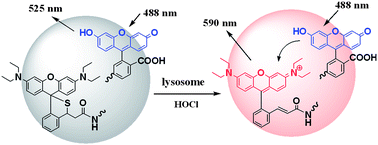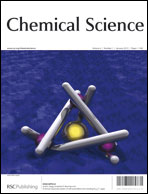A self-referenced nanodosimeter for reaction based ratiometric imaging of hypochlorous acid in living cells†
Abstract
Hypochlorous acid (HOCl) is biosynthesized from hydrogen peroxide via catalysis of myeloperoxidase in lysosomes of immunological cells. Despite being harnessed by immune systems against invading pathogens, biogenic HOCl can also damage host tissues and has been associated with a number of diseases. In this edge article, Förster resonance energy transfer based ratiometric imaging of lysosomal HOCl was achieved with silica nanoparticles comprising FITC (donor dye) and a nonfluorescent chemodosimeter which turned into rhodamine (acceptor dye) upon HOCl triggered tandem oxidation and β-elimination of the doped chemodosimeter. The nanodosimeter exhibited distinct biochemical properties relative to small molecule-based free chemodosimeters, e.g. lysosome-homing specificity and compatibility with aqueous media, enabling facile monitoring of lysosomal HOCl by conventional flow cytometry. The nanoprobe would be of broad utility for studies on in vivo generation and the impact of lysosomal HOCl in living cells or even in animals.


 Please wait while we load your content...
Please wait while we load your content...